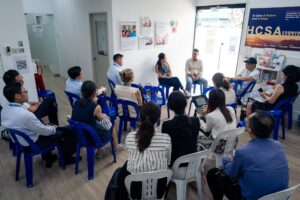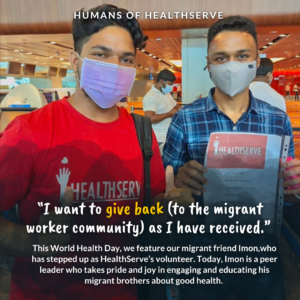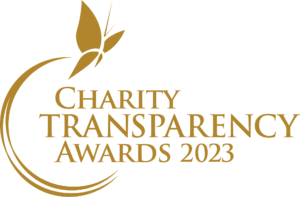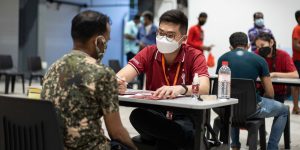At HealthServe’s Geylang office, it is a common sight to see men, primarily construction workers, on crutches, awkwardly navigating their way through our cramped office. We see arms in slings, fingers deformed, scars that tattoo the skin long after stitches have been removed. There are also many ‘invisible’ injuries – necks, shoulders, legs and backs that have suffered trauma and continue to hurt, joints that are no longer as elastic or capable.
The construction sector is the most dangerous industry in Singapore. It had the highest fatality injury rate in 2012 across sectors, and things only got worse in 2013, with a 27 per cent increase in construction fatalities.
There were 2,587 reported injuries in the construction sector in 2013. This means there are, on average, 215 workplace injuries a month (or almost 50 injuries a week) on construction sites, a number likely to be under-reported. Cai*, who has worked in Singapore for almost eight years as a construction worker, believes up to half of workplace injuries do not get reported. This is especially so for new arrivals, who are easily threatened by employers and unfamiliar with the system. Cai, who fell from a height of eight metres, was hospitalised for almost a month his injury was not reported. His employer even told him to lie to the authorities, to say that he ‘fell’ while throwing out the rubbish. In fact, there was a serious safety lapse: while working on the third storey, someone had covered up a hole, big enough for a human to fall through, with a thin, flimsy board. It gave way when Cai stepped on it.
Construction workers at HealthServe say they have little choice but to work under unsafe conditions, which are commonplace. Supervisors (‘guan gongs’) are hired specifically to discipline the men and ensure they achieve (or exceed) their work targets. Excessive workloads and productivity targets are also a common complaint and a key cause of workplace accidents. Explains another worker, Tao*: “If they can make two persons complete three persons’ work, they will do it. If one person could do it? Better still!” Workers also talked about scaffoldings being built with lesser material than required, or unqualified persons driving machinery on the worksite. Heavy loads are carried with less persons, materials are sometimes thrown down instead of being moved with the appropriate machines.
Sometimes, workers, despite being severely injured, must wait at their worksites for hours before the ‘company lorry’ arrives. They may have to plead to see doctors – or defy company orders in order to seek medical aid – and then face the prospect of not being able to retain their medical documents. Often, injuries strain employer-employee relations – an injured worker, after all, becomes a liability. Workers then need to battle for their entitlements as they wait for their work injury compensation – these include medical leave wages, living expenses and a roof over their heads.
The construction industry in Singapore remains a key contributor to its economic growth. In 2013, construction demand hit an estimated record of $35.8 billion, with forecasts for this year estimated to reach up to $38 billion[1]. Meanwhile, land and property prices continue to boom, with $15 billion worth of luxury properties[2] – one rising up to 290m – expected in the coming years. Yet, as can be seen in the steady stream of injured and broken men who come through the doors of migrant worker organisations in Singapore, we have yet to fully acknowledge the true cost of our construction boom, when measured in the lives, limbs and well-being of those who labour in it.
-Stephanie Chok
Stephanie Chok recently completed her PhD about migrant workers in Singapore. She’s now HealthServe’s part-time researcher and case worker, and looks forward to resuming her role as resident ‘kaypoh’.






